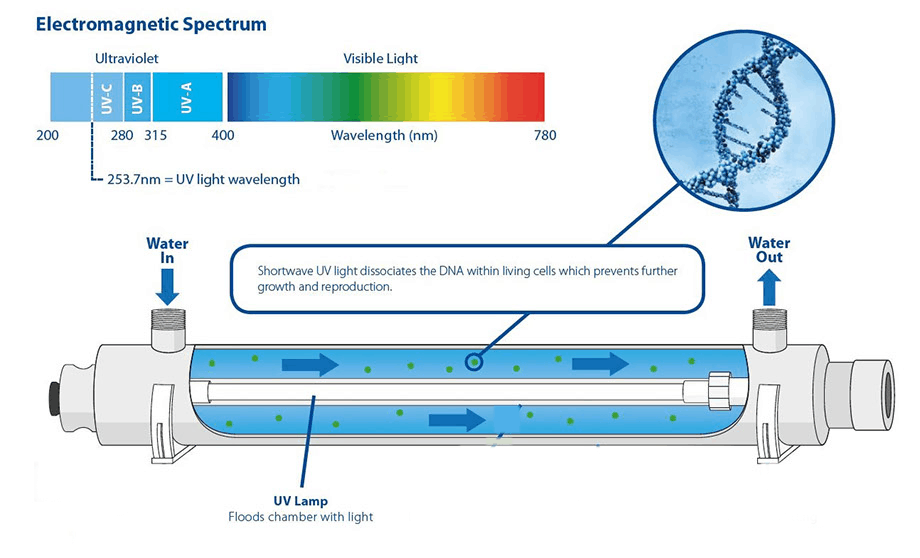Last Updated on September 3, 2024 by Rajendra Hiwale
Drinking pure water is necessary to save yourself from unwanted diseases and health issues. However, drinking water supplied to most Indian homes isn’t as pure as it should be, and it can contain dust, dirt, bacteria, germs, viruses, heavy metals, and other impurities, depending on the area. So, it is usually advised to use a water purifier in your home. If you have ever tried to buy a water purifier, you would know that there are three types of water purifiers: RO water purifier, UF water purifier (also known as gravity-based water purifier), and UV water purifier.
We have already explained what an RO water purifier is and how it works in an earlier article. In this article, we will take a good look at the UV water purifier, its mechanism, its advantages and disadvantages, and its maintenance cost.
What Is A UV Water Purifier? How Does It Work?
A UV water purifier uses ultraviolet rays to neutralize microorganisms such as bacteria, germs, and viruses so that they can no longer affect our health. The UV (ultraviolet) lamp inside the purifier emits ultraviolet rays to scramble the DNA of living organisms, making them ineffective. UV-based water purifiers can kill up to 99.99% of the harmful microorganisms. Hence, it saves you from harmful pathogens inside drinking water.
The UV lamp inside such water purifiers emits light at a wavelength of 254-nm, which is powerful enough to kill pathogens. The UV dosage that is emitted by the lamp is measured in mJ/cm². The higher the dosage, the higher the UV water purifier’s effectiveness. However, after a certain threshold, it becomes effective enough to kill most harmful microorganisms.
A UV water purifier can kill the following microorganisms from drinking water:
- Algae
- Cholera
- Cryptosporidium
- Dysentery Bacilli
- E. Coli
- Fungi
- Giardia
- Hepatitis B
- Mycobacterium Tuberculosis
- Salmonella
- Streptococcus
Usually, UV water purifiers have one or more pre-filters to remove larger contaminants such as dirt and debris.
What’s Inside A UV Water Purifier?
A UV water purifier usually has a chamber with a glass quartz sleeve that holds the UV lamp. The UV lamp, which is powered via an electric socket, emits UV rays that kill bacteria, germs, some viruses, and other harmful microorganisms. The glass sleeve is transparent so that UV rays can pass through it and disinfect the water around it. The UV lamp also features mercury vapour, which is used to fuel the lamp via vaporization. The entire enclosure is then sealed via O rings so that water doesn’t seep into the UV enclosure.
What Are The Advantages Of A UV Water Purifier?
- UV water purifier’s ultraviolet rays kill most of the harmful pathogens present in the water, making it safer to drink.
- Moreover, there are no chemicals or membranes involved in a UV water purifier, so the filtration process is quite fast.
- UV water purifiers don’t add any chemicals to the filtration process, which means that drinking water’s taste remains unaffected.
- There is no wastage of water.
- UV water purifiers have very low maintenance costs, unlike RO and some UF water purifiers.
What Are The Disadvantages Of A UV Water Purifier?
While UV water purifiers are quite safe to use, fast, and have low maintenance cost, they have their own set of disadvantages, as mentioned below:
- Since UV water purifiers don’t have a dense, semipermeable membrane like RO water purifiers, they can’t remove dissolved solids like dust, dirt, heavy metals, and salts from the water. It means that the water’s TDS can’t be reduced. To know more about what TDS is and how it affects your drinking water, read our dedicated article.
- UV water purifiers can’t even remove dissolved chemicals like pesticides from the water.
- Unlike UF water purifiers, UV water purifiers need electricity to work, which might not be ideal for some homes and localities where the power supply is unreliable.
- UV water purifiers also warm up the water when not used for a long time.
What Is A UV Water Purifier’s Maintenance Cost?
UV water purifiers have a very low maintenance cost. They need regular replacement of basic pre-filters (also known as sediment filters) and carbon filters. They usually cost anywhere between ₹300 and ₹500, and they should be changed every six months or one year. However, we don’t recommend replacing a UV lamp all by yourself, especially if you don’t have experience in doing it. Instead, you can buy our water purifier annual maintenance contract (AMC) where a certified professional comes to your doorstep and does all the work for you.
As mentioned in our dedicated article about UV water purifier’s maintenance, UV lamps don’t burn out; they solarize, which means that the intensity of the UV rays reduces over time and no longer kills bacteria effectively. In such a case, you may need to replace the UV lamp, which usually costs less than ₹500. Overall, a UV water purifier’s annual maintenance cost doesn’t exceed ₹1,000.
However, it is hard to find water purifiers these days that only feature UV filtration mechanism. Usually, even affordable water purifiers feature RO and UV filtration processes, making them more effective.
Cities We Cover: Bangalore, Delhi NCR, Mumbai, Hyderabad, Chennai, Pune






Discussion about this post